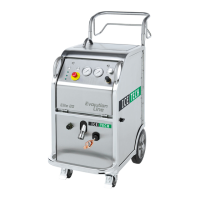25
NOZZLE SELECTION AND AIR CONSUMPTION
NOZZLE DIAMETER AND BLAST PATTERN
The nozzle selection should be based on nding the best combination of air
consumption, dry ice consumption and cleaning efciency. The selection of the
nozzle spread angle should depend on how strong or weak a cleaning effect is
desired for a given dry ice consumption.
SMALL BLAST PATTERN
A small blast pattern gives a concentrated jet with a high cleaning effect to a small
area.
WIDE BLAST PATTERN
A large spread angle (e.g. the at nozzle) results in a jet which, for the same
consumption of dry ice and air, cleans a larger area with a lesser cleaning effect.
NOZZLE SIZE
It is important to select the size of nozzle which will provide the desired air velocity
using the available compressor capacity. Choosing the right nozzle size and type
will optimize not only the cleaning effect, but also the dry ice consumption and the
time required for the cleaning process itself. Refer to the air consumption table for
guidance.
AIR CONSUMPTION TABLE
The air consumption table indicates the air consumption in relation to nozzle size
and blasting pressure. The maximum supply pressure of the Elite 20 and the
Xtreme 40 amounts to 16 bar/232 psi.
EXAMPLE OF USE OF THE TABLE
The air consumption table outlines the air consumption achieved with the nozzle
sizes available. If for example a size 8 nozzle is used at a blasting pressure of 6
bar (87 psi) the air consumption amounts to 4.2 N•m
3
/min (148.3 ft
3
/min). The
available compressor capacity will always need to be taken into consideration
and therefore it may be necessary to do some test blasts and observe the results
until the optimum combination of nozzle size and blasting pressure for a certain
application is found.

